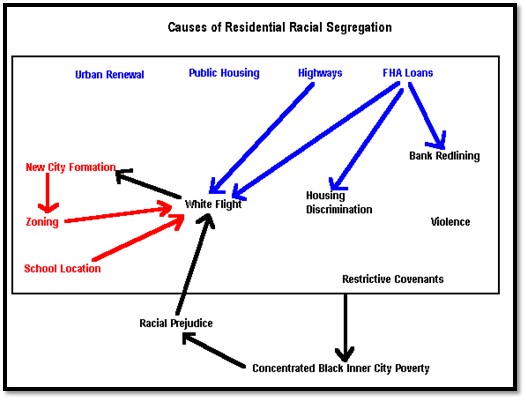Both a casual observation of our neighborhoods and recent Census data reveals that we live in a racially segregated region. The few studies that have been done suggest that discrimination is responsible in part for this segregation. A measure of segregation is found in the dissimilarity index. This index (also known as a Gini coefficient) measures the relative separation or integration of groups across all neighborhoods of a city or metropolitan area. If an area’s white-black dissimilarity index were 65, that would mean that 65% of white people would need to move to another neighborhood to make whites and blacks evenly distributed across all neighborhoods. Based on U.S. Census data provided by HUD for the Piedmont Region, we see that the Piedmont region is moderately to highly segregated.
Residential racial segregation emerged in America between 1900 and 1940 (Massey and Denton 1993; Farley and Frey 1994). In this period, over a million black Southerners migrated to cities in the North on the promise of better-paying industrial work (Hahn 2003; Wilson, 1978). In the South, the Jim Crow system governed the terms of interracial contact by subordinating blacks and enforcing strict public separation of the races, but it did not create or enforce residential segregation (Massey and Denton 1993). Segregation levels were lower in 1900 then than they are now (Farley and Frey 1994). In the North, with no such system in place, working-class whites responded with alarm to the rapid influx of potential competitors, and increasingly used violence and threats to keep the new arrivals contained in less desirable housing and jobs (Massey and Denton 1993). Between 1900 and 1921, white mob attacks and riots directed against blacks were followed by a wave of bombings aimed at black homes and offices. As the violent trend crested, whites increasingly turned to more institutionalized methods to exclude minorities (Massey and Denton 1993).
Massey and Denton (1993) provide a comprehensive review of the strategies used by white homeowners to formalize the exclusion of blacks from their neighborhoods. Middle-class homeowners formed “neighborhood improvement associations” and other voluntary property owners’ corporations, ostensibly to promote security and property values, but with the implicit purpose of preventing black entry into their neighborhoods. They lobbied city councils for zoning restrictions and the closing of businesses that attracted blacks, and they pressured real estate agencies to support their agenda. They implemented restrictive covenants, which were contractual agreements binding property owners to sell only to whites, and they pressured neighbors who were reluctant to sign. Restrictive covenants spread widely throughout the country after 1910, often under the leadership of local real estate boards.
Beginning in 1910, Southern cities began the use of municipal ordinances establishing separate black and white neighborhoods. In 1916, the Supreme Court found these ordinances unconstitutional, and in 1948, another Supreme Court ruling declared restrictive covenants unenforceable. Civil rights historian William Chafe (1980) noted that in Greensboro, NC, where our study takes place, there was a city ordinance on the books from 1914 to 1929 that prohibited blacks from living on streets that contained a majority of white households. As late as 1967, more than 90 % of Greensboro’s black residents lived in the southeast quadrant of the city, an area covering only 14 % of the city’s space, hemmed in by infrastructural barriers including an interstate highway, an industrially-zoned district, and the commercially-zoned downtown area. This same area today continues to show its history of segregation and fits HUD’s definition of a racial concentration of poverty.
